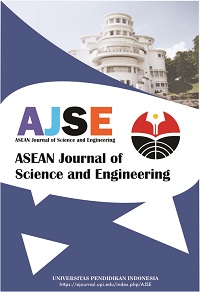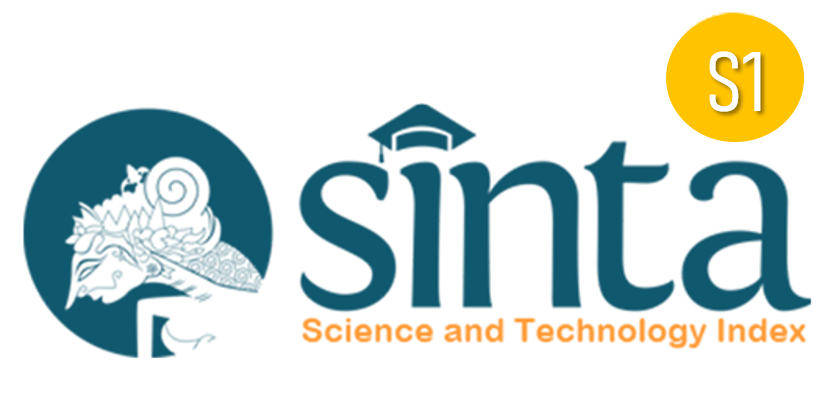The Effect of Composition Variation of Pineapple, Squeezed Orange (Citrus sinensis), and Tomato on The Electrical Properties of Voltaic Cells as an Electrolyte Solution
Abstract
This study aims to demonstrate the electrolyte solution from the fruits to be used as electrical source energy. We combined and varied the composition of the pineapple, squeezed orange, and tomato. The novelties of this research are (1) investigation of the composition of three electrolyte solutions, such as pineapple, squeezed orange, and tomato; (2) the use of these electrolytes. Experiments were done by designing the experimental apparatus and mixing fruits with different compositions. The fruits were mashed using a saw-milling apparatus. We made a series of electrical circuits to test the electrolyte solution. Data were collected every hour for 5 h. We tested the voltage, current strength, and pH. In the circuit, we used a small LED light (2 volts) for ensuring the electrical ability. The results of this study showed the presence of a voltage and current generated, turning on the LED. The more volume of the squeezed orange increased the citric acid, resulting the electrolyte solution to be more acidic (less pH). The utilization of fruits such as pineapple, squeezed orange, and tomato is effective as an electrolyte solution.
Keywords
Full Text:
PDFReferences
Akbar, S. A., Armelianda, D., and Muttakin, M. (2018). Electrolyte performance of noni fruit extracts (Morinda Citrifolia L.) for C–Zn batteries. Chemical Engineering Research Articles, 1(2), 74-81.
Aliteh, N. A., Minakata, K., Tashiro, K., Wakiwaka, H., Kobayashi, K., Nagata, H., and Misron, N. (2020). Fruit battery method for oil palm fruit ripeness sensor and comparison with computer vision method. Sensors, 20(3), 637.
Astoko, E. P. (2021). Analisis Usaha Nanas Asam Gulas (Ananas Comosus Merr.) Di Koperta Langgeng Mulyo, Desa Ngancar, Kabupaten Kediri Jawa Timur. Agrilan: Jurnal Agribisnis Kepulauan, 9(1), 79-87
Astuti, A. P., Hanafy, P. S., Nandiyanto, A. B. D., Anggraeni, S., and Usdiyana, D. (2020). Design alat peraga pembelajaran sel volta yang menghasilkan energi listrik menggunakan fermentasi larutan wortel sebagai larutan elektrolit. Journal of Engineering Practice, 2(1), 11-15.
Fauzia, S., Ashiddiqi, M. A. H., and Khotimah, A. W. I. K. (2019, March). Fruit and vegetables as a potential source of alternative electrical energy. In Proceeding International Conference on Science and Engineering (Vol. 2, pp. 161-167).
Khan, A. M., and Obaid, M. (2015). Comparative bioelectricity generation from waste citrus fruit using a galvanic cell, fuel cell and microbial fuel cell. Journal of Energy in Southern Africa, 26(3), 90-99.
Kuforiji, O., Kuboye, A. O., and Odunfa, S. A. (2010). Orange and pineapple wastes as potential substrates for citric acid production. International Journal of Plant Biology, 1(1), e4-e4.
Osahenvemwen, O. A., Okhaifoh, J. E., and Ifidon, J. O. (2020). Deployment of Fruit Juices as Battery Electrolyte. American Journal of Sciences and Engineering Research. E-ISSN-2348-703X, Volume 3.
Penniston, K. L., Nakada, S. Y., Holmes, R. P., and Assimos, D. G. (2008). Quantitative assessment of citric acid in lemon juice, lime juice, and commercially-available fruit juice products. Journal of Endourology, 22(3), 567-570.
Rajagukguk, A. H., Ginting, M. H. S., Sundari, E., and Misran, E. (2020, December). Effect of wuluh starfruit (Averrhoa Bilimbi) electrolyte filtrate addition on making hydrogel aluminum battery based on carboxymethyl cellulose. In IOP Conference Series: Materials Science and Engineering (Vol. 1003, No. 1, p. 012130). IOP Publishing.
DOI: https://doi.org/10.17509/ajse.v3i2.33671
Refbacks
- There are currently no refbacks.
Copyright (c) 1970 Universitas Pendidikan Indonesia

This work is licensed under a Creative Commons Attribution-ShareAlike 4.0 International License.












